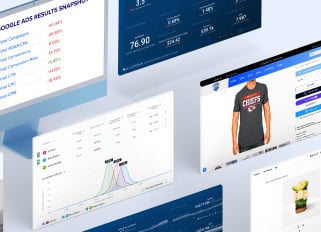
The Ultimate Amazon Seller’s Acronym Dictionary - Updated 2023
Today, there are approximately 2.3 million active Amazon sellers. As with any large community, it’s normal for them to develop what seems like their own language, one where acronyms play an important role.
If you’re new to the Amazon seller world, you might not know your “ACOS” from your “ODR” simply because you're unfamiliar with the acronyms. Luckily, it is possible to get the hang of the terminology, allowing you to not just walk the walk, but talk the talk, as an Amazon seller.
Here, you’ll find a list of some of the most commonly used Amazon seller acronyms. Some are platform-specific, while others relate to the entire e-commerce space. However, they are all important, allowing you to communicate with other sellers or Amazon with greater ease, should the need arise.
What Is an Acronym?
The term “acronym” is actually fairly new, coming in near 1940. Acronyms are abbreviations created by taking some of the letters of the words involved in a phrase. Usually, the first letter of each major word is involved (think NASA), though some acronyms use several letters from a single word (as with radar). Technically, an acronym should be pronounced like a separate word, as well.
While many people assume that phrases that are constructed of the first letter of the words are pronounced by reciting the letters (like FBI) are acronyms, that isn’t the case. Those are actually initialisms. “Initialism” is much older, dating back to the mid-1800s.
The acronyms and initialisms usually function as a form of shorthand. Their main purpose is to expedite conversations, referring to complex concepts with just a few letters.
What Is an Amazon Seller Acronym?
There isn’t a formal Amazon seller acronym category. It’s simply a collection of terms that are widely used by Amazon sellers when discussing e-commerce on Amazon.
In fact, many of the acronyms apply widely to the e-commerce (or, even, general commerce, accounting, and finance) space. However, some are platform-specific, referring to Amazon products, services, and features.
Since most people envision both initialisms and acronyms for this, this ultimate Amazon seller acronym dictionary is going to contain a bit of both. That way, it covers more bases.

The Ultimate Amazon Seller Acronym Dictionary
ACoS – Advertising Cost of Sale
ACoS is a reflection of the percentage of attributed sales that a seller spends on advertising. It allows sellers to estimate the effectiveness of their various advertising campaigns, such as launching an Amazon Lightning Deal or using e-commerce email marketing software for automated emails.
AMZ / AMZN - Amazon
Some Amazon sellers use AMZ or AMZN in place of writing out the company’s name. AMZN is actually Amazon’s stock ticker symbol on the Nasdaq, as well, while AMZ (or a variant) is used in some of the European markets.
API – Application Programming Interface
API is code that allows two programs to communicate. It’s commonly referenced if you use Amazon seller software that offers integrations or certain kinds of customizations.
ASIN – Amazon Standard Identification Number
An ASIN is a unique 10-character string used to identify individual products that are listed on Amazon. It’s a lot like a Social Security Number for products, as each one gets its own ASIN.
B2B – Businesses-to-Business
If business is conducted between two companies instead of a company and a consumer, it’s B2B.
B2C – Business-to-Consumer
When business is conducted between the actual consumer and the company, it’s B2C.
BOGO – Buy-One, Get-One
A promotion approach, BOGO deals allow customers to get something after paying full price for an item. It could be a buy-one, get-one-free or a buy-one, get-one at a discount. With the first approach, you offer two products for the price of one.
With the other, the second item in the deal gets a percentage off the retail price. For example, BOGO 50 percent off would make the second product half-price while leaving the first item at full price.
BSR – Best Sellers Rank
An Amazon-specific designation, a BSR awarded when a proprietary algorithm calculates a product’s sales and determines how it compares to other products in a particular category.
COGS – Cost of Goods Sold
The complete total of all costs associated with the creation and sale of a product or service. For example, it could involve manufacturing, packaging, shipping, taxes, and other expenses.
CPC – Cost-per-Click
An advertising approach that charges the advertiser every time a person clicks on their ad.
CPM / CPI – Cost-per-Mille / Cost-per-Impression
Both of these metrics reflect how much it costs for an ad to receive 1,000 impressions.
CTR – Click-through-Rate
Your CTR is determined based on the number of ad viewers who actually interact with (click) your advertisement. It’s calculated by dividing the number of clicks by the total number of impressions.
DDP – Delivered Duty Paid
With this, the supplier is handling carriage and import costs, such as tariffs and duties.
DS - Dropshipping
DS covers the activity of dropshippers, which are sellers who use a fulfillment approach that doesn’t require them to maintain inventory personally.
EAN – European Article Number
Also known as an international article number (IAN), this is a 13-digit string, not unlike an ASIN. It just identifies a product that is traded globally instead of being Amazon-specific.
EFN – European Fulfillment Network
European Amazon sellers can use this option to fulfill orders from their home locations in other European marketplaces.
EOD – End of Day
Typically refers to the close of a business day, designating when a task will be completed by, usually at the latest.
EXT – Chrome Extension
A small piece of software that alters, removes, or adds a function to the Chrome browser.
FBA – Fulfillment by Amazon
A service that allows third-party sellers to have their products stored at Amazon fulfillment centers. When a customer purchases one of these items, Amazon handles the packaging and shipping, as well as customer service after the sale.
FBM – Fulfillment by Merchant
A fulfillment process where the seller handles their own packing, shipping, and customer service.
FC – Fulfillment Center
The large warehouses where products from third-party sellers are stored prior to sale and shipment.
FCA – Free Carrier
An approach where the seller is required to take the product to a specific destination, such as a port, airport, or warehouse, as identified by the buyer. The seller is also responsible for export clearance, if relevant.
FNSKU – Fulfillment Network Stock Keeping Unit
A 10-character string identifying products store in Amazon fulfillment centers.
FOB – Free on Board
The supplier is responsible for ensuring your products get from a manufacturing facility to a port, with the expense of the service typically wrapped into production costs.
GLN – Global Location Number
A unique identification code for a specific physical location.
GTIN – Global Trade Item Number
A unique identifier that is used to find product information.
ISBN – International Standard Book Number
Either a 10- or 13-character string that is specifically for books and book-like products, such as eBooks or audiobooks, and is unique to each specific one.
KB – Knowledge Base
A repository of information that is accessible online.
KPI – Key Performance Indicators
Metrics that assist sellers in determining the health of their business and progress toward objectives.
MAP – Minimum Advertised Price
The lowest amount a seller can advertise the product costing. If a seller wants to sell the item for less, they cannot advertise that specific price openly. With this approach, the actual price is usually not revealed to the customer until the item is placed in their cart or another action-oriented step is completed by the shopper.
MCF – Multi-Channel Fulfillment
When sellers use multiple platforms to facilitate sales, such as an Amazon account and a Shopify website.
MCI – Multi-Country Inventory
A service that allows FBA sellers to have inventory stored in multiple countries, supporting delivery to buyers from local fulfillment centers.
MOM – Month-over-Month
A comparison metric to track differences between two consecutive months.
MTD – Month-to-Date
A metric reflecting progress between the 1st of the current month and the current date.
MOQ – Minimum Order Quantity
The lowest order volume a manufacturer will allow for a particular product.
MSRP – Manufacturer’s Suggested Retail Price
The price point the manufacturer of the item recommends sellers use. Sellers are not required to list a product for MSRP, and many choose not to do so. On Amazon, when a product is listed for less, both prices are shown, allowing the customer to see the difference between MSRP and what they would pay.
MWS – Marketplace Web Services
Refers to Amazon’s Marketplace Web Services, where sellers can access API keys.
NAFN – North American Fulfillment Network
Like the EFN, but for North American sellers and the North American markets.
NIS – New Item Setup
The process of creating a new product, including securing an ASIN, completing the item detail page, and other required steps.
NP – New Product
An item that is newly listed.
NR – Non-Replenishable
An item that is no longer available.
OA – Online Arbitrage
An approach that involves sourcing products from an e-commerce platform that offers a low price and selling them on another platform at a higher price.
ODR – Order Defect Rate
A percentage of orders that had negative feedback from buyers, a claim through the A-to-Z Guarantee program, or a chargeback on a credit card.
OEM – Original Equipment Manufacturer
Parts or equipment that was created by the manufacturer of the larger product they work with or on, such as a vacuum manufacturer selling filters for its own vacuums. This term separates manufacturer-created parts and equipment from those created by third-parties.
OOS – Out of Stock
When an item isn’t currently available for purchase, and may or may not be available again in the future.
PED – Prime Exclusive Discount
When a lower price is offered by FBA sellers on items eligible for Prime to Prime members.
PL – Private Label
Items that are packaged under the retailer’s name instead of the item’s manufacturer’s.
PPC – Pay-per-Click
See CPC.
Q1, Q2, Q3, Q4 – Quarter one, quarter two, etc.
A reference to each financial quarter within a year, with Q1 being January to March, Q2 being April to June, Q3 being July to September, and Q4 being October to December.
RA – Retail Arbitrage
The process of locating low-cost products at a retail store (typically underpriced ones) and reselling them on an e-commerce platform, such as Amazon, for a higher price.
RFQ – Request for Quote
The process of asking for a price estimate on wholesale items.
ROI – Return on Investment
A metric reflecting gains or losses based on how much money a seller invested and how much money they received from that investment. Usually, it is calculated as a percentage using the following formula: ROI = Gains – Cost of investment / Cost of investment
SC – Seller Central
The site where third-party (FBA and FBM) Amazon sellers manage their seller accounts.
SEO – Search Engine Optimization
A process of refining the content of a website or listing to have it appear higher on a search engine’s result list and maximize visitors.
SFP – Seller Fulfilled Prime
An Amazon program that gives FBM sellers the ability to have a Prime badge on a listing. It requires the seller to adhere to Amazon’s shipping timeline.
SKU – Stock Keeping Unit
Company-specific machine-readable codes that identify products, usually for the purpose of tracking inventory internally.
UPC – Universal Product Code
Machine-readable codes that identify products that aren’t company-specific.
VA – Virtual Assistant
An administrative employee who helps a seller while working remotely.
VC – Vendor Central
The site where first-party sellers manage their relationship with Amazon.
WL – White Label
Similar to private labels, white labeling involves a manufacturer removing all of its branding from a product and agreeing to allow the seller to rebrand the item.
WS - Wholesale
The process of selling large quantities of products below retail price, usually to companies or individuals who intend to resell the item either in a store on through an online platform.
1P – First-Party Sellers
A term describing brands that are distributed and sold directly by Amazon through its platform.
3P – Third-Party Sellers
Merchants not directly associated with the platform, which, in this case, is Amazon. Typically, this covers anyone selling FBA or FBM.
Connect With Us
Recent Post

.png)







Tell us what you think!